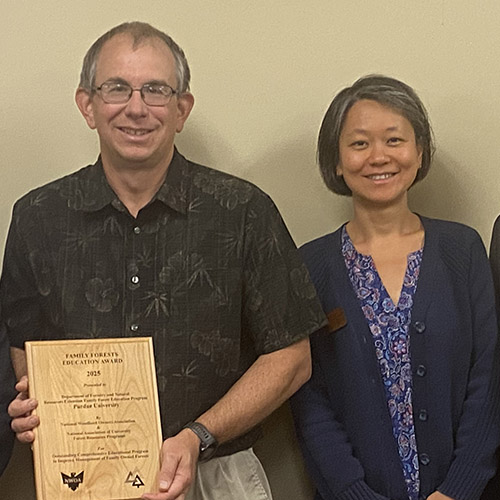Tales from FNR with Professor Emeritus Harvey Holt
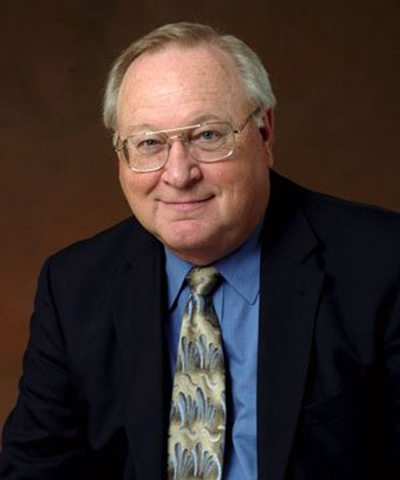 When Dr. Harvey Holt came to Purdue’s Department of Forestry and Natural Resources in 1975 in a research and extension position, he brought a background in forest and right-of-way vegetation management.
When Dr. Harvey Holt came to Purdue’s Department of Forestry and Natural Resources in 1975 in a research and extension position, he brought a background in forest and right-of-way vegetation management.
Holt, who had earned his PhD at Oregon State University, came to Purdue after a four-year stint at the University of Arkansas.
“It was a golden era. You had a new department head in Mason Carter who had only been here for a couple of years and he was still shaping the department and changing the way things were done,” Holt said. “Mason was at Auburn when I was at Arkansas and we were both working in forest vegetation control. He was a little more lab oriented while we were more field oriented. When he became department head, he approached us about coming to Purdue. At that time, we had an opportunity to go Auburn, a potential job in Borneo and at Purdue. We had obviously experienced the south and Auburn was just deeper in the south. The Borneo position needed people with international experience because it was so remote. We had two young children at the time, so I told Barb maybe we should go to Purdue. Neither one of us really knew exactly where Purdue was.”
Luckily for generations of Purdue students, the Oklahoma natives took the leap and came to West Lafayette to a school most of their family thought was ‘an Ivy League College somewhere in the East.’
When Holt arrived, the urban forestry program in FNR was directed by Jack Callahan, who was an economist and focused much of the curriculum on managing urban forests and the value of trees.
“When Jack retired, Mason said, ‘you work on rights of way and they come into town too, so how would you like to pick up this urban forestry area,’” Holt recalled. “I suggested that would be fine, but that I wanted to add arboriculture and commercial tree care to the curriculum. That’s really where it all began. The only thing I brought to the table was the fact that I had this interest in tree climbing. We had never had any particular courses about urban tree care, but we had been involved with the utility side. At that time, there was an organization called the International Society of Arboriculture, which was an umbrella for municipal, utility, commercial and academic areas of professional careers. We had been going to their meetings for years and that is where we began. I would like to note that a great deal of what we did here at Purdue with respect to urban forestry is a result of Rita McKenzie being here at the same time as a graduate student and then as professional staff in much the same capacity as Lindsey Purcell has been.”
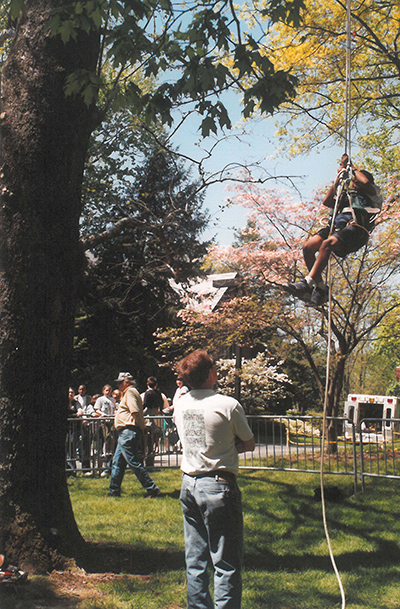 With no previous formal arboriculture training, Holt went to a three-week program at Kent, where Davey Tree Expert Company’s environmental services group put on a training program and taught Holt and others basic commercial tree card, including how to climb trees with ropes and saddles. Holt made his first climb up to 50 feet at Squirrel Park once he returned from the class ‘just so I could see what 50 feet looked like from up in the tree.’
With no previous formal arboriculture training, Holt went to a three-week program at Kent, where Davey Tree Expert Company’s environmental services group put on a training program and taught Holt and others basic commercial tree card, including how to climb trees with ropes and saddles. Holt made his first climb up to 50 feet at Squirrel Park once he returned from the class ‘just so I could see what 50 feet looked like from up in the tree.’
In 1982, Holt began teaching an arboriculture course. At first, the course was only two afternoons a week and only met for one half of the semester. Soon the class extended to the whole semester and was nearly always maxed out at 20 students. Eventually, Holt started a second class on tree management, teaching about tree inventories and management programs.
“Harvey was a great professor,” Cody Flint, 2017 interdisciplinary ag alumnus said. “He gave his students the knowledge to be successful in the urban forestry industry, plus the introductions to network in the industry as well. Before Harvey’s class I was looking to go into traditional forestry, but at that time there were limited openings and lots of students applying for them. Harvey helped open the world of arboriculture for me. There were tons of options for a student to try and he helped introduce his students to the companies in a very relaxed way, which helped the students find the company that fit them. Harvey and Barb really cared for the students like we were their own kids. They often would have us over for meetings that turned into home-cooked dinners. I kept in touch with Harvey during my career as it progressed and he invited me back to talk to the students in his classes.”
Creating a family atmosphere and developing relationships with their students created a bond between the Holts and Harvey’s students that remains to this day.
Holt’s wife of 58 years, Barb, recalled events at their home which served to develop relationships between students and industry professionals.
“It was nice because Harvey had a lot of industry people that would come talk to his classes or meet with student groups and we would have barbecues for career day, etc., where they could meet our arboriculture and urban forestry students informally,” Barb said. “Most of our students had jobs for the summer and when they graduated, which was important to Harvey because that is what we were here for.”
2008 alumna Olga Kildisheva noted it wasn’t just Harvey who impacted students.
“I first got to know Harvey through the undergraduate forestry course he led at Purdue,” said Kildisheva, who is a project manager for The Nature Conservancy in Bend, Oregon. “What struck me the most about him was how genuinely he cared about his students - taking the time to get to know all of us personally. Even outside the classroom, Harvey and Barb were incredibly generous and welcoming, inviting students to their home for annual barbeques, participating in FNR events, and creating a community wherever they went. Even after retirement and a move to the West Coast, they have kept in close touch and been an active part of the Washington Purdue alumni community, organizing events to bring the forestry gang that ended up on the West Coast back together.
“Harvey has always wanted to help his students (even long after their classroom days were over) to find opportunities they were passionate about. While at Purdue, Harvey organized conference trips and field tours to expose his students to urban forestry, give them hands-on training, and help them network with industry professionals. For many of us, this helped chart the course for our post-graduation futures. I'm grateful for the kindness, generosity, and genuine care that Harvey and Barb have brought to the Purdue community over the years.”
Holt helped his students overcome fears and push past their struggles in the classroom and in life.
 “We had a lot of independent work and we each had to take a topic and research it and present it to the class,” recalled Stephanie Foster-Miller, a 1992 alumna who is now a regional urban forester. “It was great and I loved it because I was an older student and it allowed me to get more comfortable in front of people because I was so scared and nervous. Harvey also was very kind because tree climbing was scary to me as I am terribly afraid of heights. I remember getting in the tree and hanging there about five feet up and bouncing out. We had to go 25 or 50 feet up and then 25 feet out on the branch. One day, Harvey came by and just grabbed the rope and started pulling and made me get up in the tree. I was bawling like a baby. When I came down, he came over and said ‘I’m so sorry. If I had known it would have been so painful for you, I wouldn’t have done that.’ I said ‘yeah, but I’ve got to pass this class.’ That was just like him, so tender and caring, but he wanted his students to learn and sometimes that meant doing hard things and not just giving it to you. I am really grateful for that now, because not everything was spoon fed.”
“We had a lot of independent work and we each had to take a topic and research it and present it to the class,” recalled Stephanie Foster-Miller, a 1992 alumna who is now a regional urban forester. “It was great and I loved it because I was an older student and it allowed me to get more comfortable in front of people because I was so scared and nervous. Harvey also was very kind because tree climbing was scary to me as I am terribly afraid of heights. I remember getting in the tree and hanging there about five feet up and bouncing out. We had to go 25 or 50 feet up and then 25 feet out on the branch. One day, Harvey came by and just grabbed the rope and started pulling and made me get up in the tree. I was bawling like a baby. When I came down, he came over and said ‘I’m so sorry. If I had known it would have been so painful for you, I wouldn’t have done that.’ I said ‘yeah, but I’ve got to pass this class.’ That was just like him, so tender and caring, but he wanted his students to learn and sometimes that meant doing hard things and not just giving it to you. I am really grateful for that now, because not everything was spoon fed.”
Holt not only impacted students in the classroom but provided resources for them throughout their careers far beyond graduation, Dr. Greg Dahle, a 1995 forestry alumnus and 2005 master’s degree recipient, said.
“Harvey has influenced my career as an arborist, educator and researcher in countless ways,” said Dahle, associate professor of arboriculture and urban forestry at West Virginia University. “I took Harvey’s arboriculture course as a wildlife senior, figuring it might be worthwhile to know how to climb trees so I could check on birds’ nests in tree canopies. Little did I know that I was discovering a profession. After graduation, I had a summer job monitoring waterfowl nesting success. As this job ended and no reasonable wildlife positions were available, I turned to waiting tables. At that time, I ran into Harvey during a visit to Purdue, he then called me a couple of weeks later to let me know about a utility arborist position out in California. Three weeks later, I had relocated to the West Coast and was discovering my career in arboriculture and utility vegetation management. To this day, I continue to pay it forward by sending out job announcements to current students, alumni and colleagues.
“In short, Harvey taught me how a simple message can help launch a career and passion. During my master’s (studies), I learned how to teach and research and benefited as Harvey introduced me to practitioners, business owners and researchers in the arboriculture world. These contacts have served me well to this day. I also was fortunate to get to know Barb over many fantastic dinners in West Lafayette, Montreal, Nashville or Oslo. Harvey and Barb continue to be present in my work and personal life.”
In addition to teaching arboriculture and tree management, Holt continued his research on vegetation management. In 1978, he expanded his reach from forestry plots and utility rights-of-ways to railroads.
“In St. Louis at the Weed Science meeting, I met up with my Dow contact and we were talking about what sessions we were going to go to and he said he was going to go to a meeting of railroad contractors,” Holt said. “It sounded interesting, so we went to the meeting. They were having a training program because commercial applicators had to be certified. We met the group and there were different topics presented by industry people, and then they started taking tests for several different states, because each state had its own licensing test. That led to a discussion, including John Osman, who was the head of the entomology department at the time and had been on a special task for the EPA Office of Pesticide Programs which defined the various categories for commercial applicators. We ended up putting together an applicator training program in Indianapolis in 1979. The net effect was that people could come to one program and be licensed in a couple of dozen states. And the program still goes on to this day, but now it is run by a faculty member from the University of Missouri, who also is a Purdue graduate.”
Through the applicator training program, Holt built relationships with the railroad personnel, which led to work on vegetation management and herbicide testing along the railways, as well as a common memory for those who worked with Holt, that of Big Blue, a crew cab truck that was equipped with hi-rail wheels.
“We used it in the arboriculture class to haul gear out to the climbing sites and such, then we finagled around and got high rails put on it so it was track accessible,” Holt remembered. “So then, instead of doing vegetation plots or test plots on utility right of ways, all of a sudden, we could do it on railroads. KB&S Railroad was our primary test site somewhere between West Lafayette and Kankakee. We travelled all over the east looking at railroads and potential test sites, tracks that had been abandoned or were not being managed very well.”
 Big Blue was driven by students, interns, summer workers and more and was the conduit for adventures and research.
Big Blue was driven by students, interns, summer workers and more and was the conduit for adventures and research.
“I think that his faith and trust in me to drive a big truck with two diesel things on the back and railroad parts on the front gave me confidence I could do anything,” Foster-Miller said. “He let me drive that truck around, which was long and wide and huge with a lot of diesel on board. He gave me a lot more responsibilities than I felt confident to do, but it was like ‘ok, I can do this.’ That impacted me a lot.
“Through the years he has always been very supportive and interested beyond just the classroom. I consider him my professional mentor. He gave me a job when I needed it, working for him and Bill Chaney. They took me on research adventures to California and to my first ISA convention in Philadelphia where I met people I still know and work with today. Harvey also took us to visit different professionals. I remember coming to ACRT and Beth Buchanan was there. She walked in wearing a skirt and jewelry and earrings and I thought ‘ok, if she is doing this and she’s a vice president of a company, I can do this.’ I don’t know that if Harvey had not brought us to meet her that I would have been as comfortable in me being more of a girly girl in forestry.”
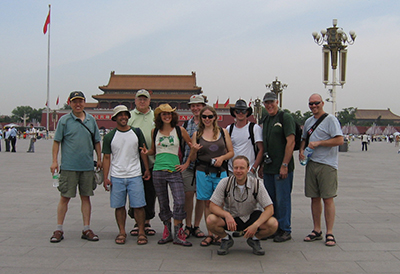 In June 2006, Holt was among a group of five faculty members, including Dr. Guofan Shao and Dr. Doug Jacobs, and five students who took a two-week tour to China. The group visited several natural reserves across the country, and witnessed the impacts of the natural forest protection program on forest resources and timber production. They saw empty sawmills and weedy nurseries.
In June 2006, Holt was among a group of five faculty members, including Dr. Guofan Shao and Dr. Doug Jacobs, and five students who took a two-week tour to China. The group visited several natural reserves across the country, and witnessed the impacts of the natural forest protection program on forest resources and timber production. They saw empty sawmills and weedy nurseries.
“As an urban forester, Harvey paid much attention to urban trees,” Shao recalled. “He was bothered by the white paint on tree bark in every city we visited. Harvey particularly enjoyed local culture near the Tibet Autonomous Region. Harvey was brave enough to sample local foods, particularly in Chengdu. The group enjoyed the spicy hot pot, one of typical Chinese cuisines. The experience in China was unforgettable and Harvey’s participation in this trip made our experience more enjoyable.”
Purdue became home for the Holts as they were part of the department for nearly 35 years.
“There was a family here,” Barb Holt said. “It was really nice to have the department and the wives and the families so close. There was a heady wives club back then. We were really close and we really worked hard doing things for the department. At one point, the forestry wives club made cakes for each table at the spring banquet with each cake shaped like a different county. Another year, it was flowers from that county. One year, Harvey took all of the secretaries out for a picnic on the railroad and even though they had track time reserved, they saw an engine coming through with its lights on and they all abandoned ship. They will never forget that.”
Harvey explained further.
“We had the crew cab truck and we had also acquired a track trailer and had all of the clerical staff out with us,” Holt said. “They certainly had an interesting experience, coming around the curve and there’s a train coming at you. We had to clear the rail fairly rapidly. The train went by and we set back on. We knew the train was just going down and dropping off cars so all the way as we went on up toward Fowler, you kept looking back and looking for a smoke cloud.”
Where Are They Now?
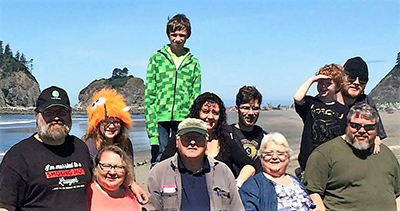 The Holts are very much tied to Purdue. Their son Eric completed his bachelor’s degree in building construction management technology in 1991, a master’s in 2009 and a PhD in 2015 and is now a professor at the University of Denver. Their daughter Susan (Holt) Carroll, earned her bachelor’s in English in 1992, and is now a lawyer. They have five grandchildren, two in Seattle and three in Denver.
The Holts are very much tied to Purdue. Their son Eric completed his bachelor’s degree in building construction management technology in 1991, a master’s in 2009 and a PhD in 2015 and is now a professor at the University of Denver. Their daughter Susan (Holt) Carroll, earned her bachelor’s in English in 1992, and is now a lawyer. They have five grandchildren, two in Seattle and three in Denver.
In 2009, Harvey retired and the Holts embarked on a new adventure to the Seattle area, carrying with them the memories of the many students, faculty and staff they worked with over the years as well as of their children playing in the creek at Martell Forest or hitting each other with palm branches on Easter Sunday at their local church.
Harvey had a consulting business from 2010 to 2015, testing herbicides across Washington, Oregon, Idaho and Utah.
“One day, I decided I didn’t really want to die walking a railroad right-of-way,” Holt said with a laugh. “When you are down in the valley and you have no cell phone reception, it makes you think. It’s also different as a consultant. It was more of a hobby and it got to be not that much fun, but we still got to travel throughout the Western United States looking for test sites.”
Holt is now the president of his homeowners’ association, where he has learned all about elevators and sea walls and works with the arborists and landscapers who come onto the property. He has replaced his professional technical books (save his old dendrology book) with cookbooks.
“He cooks for me,” Barb said. “I have spices and things in my home I have never seen or thought about before. He does a lot of foreign foods and a lot of comfort foods.”
The Holts maintain their FNR and arboriculture family connections through Facebook and phone calls and dinners at home and abroad with former colleagues and students.
Whether a student or colleague, everyone has a Harvey Holt story, from grilling out by the railroad tracks while awaiting nighttime herbicide applications, experiencing great food together from sushi to Mediterranean, or getting poison oak wading through the woods on a research trip.
“Harvey is a touch point for everybody who knows him,” Foster-Miller said. “All of our time with him links us. Everybody has wonderful stories about him and it’s fun to hear them and share them and share laughs. That is a bond we have.”
What They are Saying About the Holts
Scott Jamieson, vice president of the Midwest Division at Bartlett Tree Experts, said that helping his students find their footing in the career world was as important to Holt as classroom work.
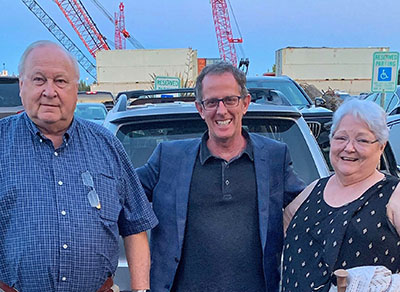 “Harvey was very laid back and practical. Did he even give a test? I don’t know,” the 1984 alumnus said. “He was passionate about connecting his students with the profession and committed to those relationships after Purdue. His focus was to get students employed in the industry. My time in FNR launched my career and people like Harvey helped set my course. He was a huge influence after I left Purdue and he connected me with many opportunities. He invited me to speak to his students, promoted internships with our company and allowed me to maintain a strong relationship with FNR and the College of Agriculture. He came to visit me several times when I was CEO of The Care of Trees. His visit and tour with our arborists gave him the idea to create the Midwest Urban Tree Care Forum where he marshalled students from many Midwest universities to come to the Chicagoland for a weekend. The goal was to expose students to the amazing opportunities in urban forestry and arboriculture.”
“Harvey was very laid back and practical. Did he even give a test? I don’t know,” the 1984 alumnus said. “He was passionate about connecting his students with the profession and committed to those relationships after Purdue. His focus was to get students employed in the industry. My time in FNR launched my career and people like Harvey helped set my course. He was a huge influence after I left Purdue and he connected me with many opportunities. He invited me to speak to his students, promoted internships with our company and allowed me to maintain a strong relationship with FNR and the College of Agriculture. He came to visit me several times when I was CEO of The Care of Trees. His visit and tour with our arborists gave him the idea to create the Midwest Urban Tree Care Forum where he marshalled students from many Midwest universities to come to the Chicagoland for a weekend. The goal was to expose students to the amazing opportunities in urban forestry and arboriculture.”
Dave Apsley, a 1985 alumnus, noted that Holt challenged his students but instilled the confidence that they could accomplish any task.
“I was in the class the first time that the arboriculture class was offered, so we all learned together,” said Apsley, a natural resources specialist with Ohio State University Extension. “He wasn’t afraid to admit that it was new to him. I also worked as a work student for Dr. Holt and Dr. Fischer in the FNR Extension office while I was an undergraduate in forest management. This exposed me to applied research, data collection and management, and vegetation management. I was able to assist with the establishment of herbicide trials at Martell Forest and on state forests. On one occasion, Harvey sent me to a state forest in southern Indiana to establish a trial to determine the effectiveness of various herbicides to control Japanese honeysuckle. I had no idea what I was getting into. When I arrived at the site, I was greeted with an impenetrable clear cut, covered with four to six feet of Japanese honeysuckle. With the help of a forest technician from the forest (and a few machetes), we were able to improvise and successfully establish the trial. At first, I was overwhelmed and wanted to throw in the towel, but Harvey was trusting and gave me the 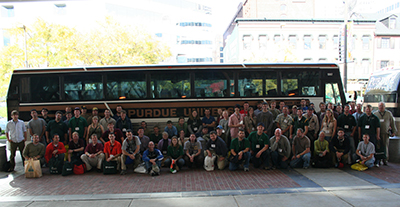 confidence to find a way to accomplish the task. My experience with Harvey and Purdue Forestry Extension exposed to me a whole new realm of forestry and applied research, and were big factors in my eagerness to begin my career in forestry extension. I often think of Harvey when I’m applying herbicides on my Christmas tree farm, teaching a session on managing invasive plants to woodland owners or presenting on sprayer calibration at a commercial pesticide applicator training.”
confidence to find a way to accomplish the task. My experience with Harvey and Purdue Forestry Extension exposed to me a whole new realm of forestry and applied research, and were big factors in my eagerness to begin my career in forestry extension. I often think of Harvey when I’m applying herbicides on my Christmas tree farm, teaching a session on managing invasive plants to woodland owners or presenting on sprayer calibration at a commercial pesticide applicator training.”
Melvin Johnson, vegetation operations coordinator for Entergy in New Orleans, worked with a consulting agency doing vegetation management before he came to Purdue to work on his master’s degree under Holt, which gave him experiences that directly impacted his career.
“We traveled the country doing projects with tree growth regulators and also with some herbicides that were coming out on the market and needed information regarding the rates and efficacy with different weeds and different geographical locations,” Johnson, a 1997 master’s alumnus, explained. “We went out and did test plots for those manufacturers. We provided the information they could put on their label, advising potential buyers about their product, how to use it, at what rate, and which weeds it would control and which it would not. We travelled all over the country doing research test plots, from Nebraska to Colorado, to Wisconsin, Ohio, and Louisiana, all over. It was all great, but I do remember when we visited Colorado, we actually got a chance to go into the mountains and enjoy it as if we were tourists. It was my first time being in the mountains, so it was unbelievable. That research put me on top of the world literally. Being where I am right now was a direct result of that. It paid off tenfold. When I finished graduate school, it enabled me to hire on directly with the utility rather than working as a consultant.”
Johnson said that in addition to the work relationship, Harvey and Barb Holt impacted him through their caring nature.
“He was a cool, laid-back man and we had a whole lot of fun,” Johnson continued. “Barb and Harvey were just really nice people. He was straightforward and easy to get along with. He was willing to accommodate the student and listen to their concerns. He was very flexible and forgiving. He’s really concerned about you as a person. Then, they would take you into their house and feed you. We went over for holiday dinners and whatnot. I graduated in 1997 and we still keep in touch today. In fact, my wife and I had lunch with Harvey and his wife in New Orleans a few weeks ago. Whenever something happens close to New Orleans – tropical storm, hurricane, tornado, whatever – he calls me and says ‘hey, how are you doing man?’ He keeps track of everything and what’s going on in your area and occasionally gives you a call.”
Joel Dryden, senior vice president of operations and general manager of the Pacific Denkmann Company and Pilchuck Tree Farm, took Holt’s Arboriculture 444 class with several friends his senior year and also saw Holt’s caring nature extend outside of the classroom.
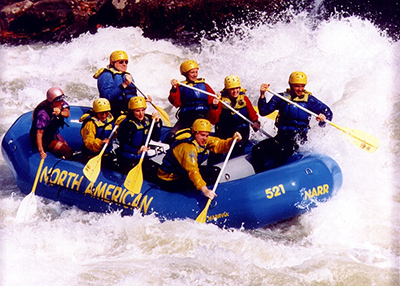 “You’re taking a class on how to climb trees and prune trees, what’s not to like about that,” Dryden, a 2008 forestry major said. “Harvey was extremely laid back, but informative. He taught you everything you could imagine. If you had a question, he would sit down and work with you on it and try to come up with an answer you could understand. He was also really jovial and liked to have a good time.
“You’re taking a class on how to climb trees and prune trees, what’s not to like about that,” Dryden, a 2008 forestry major said. “Harvey was extremely laid back, but informative. He taught you everything you could imagine. If you had a question, he would sit down and work with you on it and try to come up with an answer you could understand. He was also really jovial and liked to have a good time.
“Harvey had summer work and he usually hired a student or two to help, so he hired me between when I graduated and when I got my first real job. I helped him do some herbicide tests and took notes and did some data entry. When I got this job interview in Seattle, he loaned me his personal suitcase because I was a poor college kid and didn’t have a suitcase. If I had wanted to pursue a job in arboriculture more than in forestry, I know I could have leaned on him to get a job. He had connections all over the place in that world. I relied on him for a reference in getting my first job at the DNR, and I certainly learned a lot through Harvey. He is really invested in his students and has made an effort to stay in touch with us”
Dryden returned the favor for Holt, when he was doing some consulting work after his retirement from Purdue. Dryden helped set Holt up with some field sites for testing herbicides in a forest setting. The two also used to meet up for dinner once a year in Seattle and as well as at alumni gatherings in the area.
In 2015, Holt organized an FNR alumni event at his condominium with at least 10 former students in attendance.
Whenever the Holts travel to a city where a former student, colleague or friend lives or vice versa, good food will be shared, stories will be told, and laughter is a certainty.
And perhaps Holt will drop some nuggets of wisdom like this piece of advice he had for undergrads in the 1984 Purdue FNR Log book.
“Eat a live toad in the morning and nothing worse can happen to you the rest of the day.”





